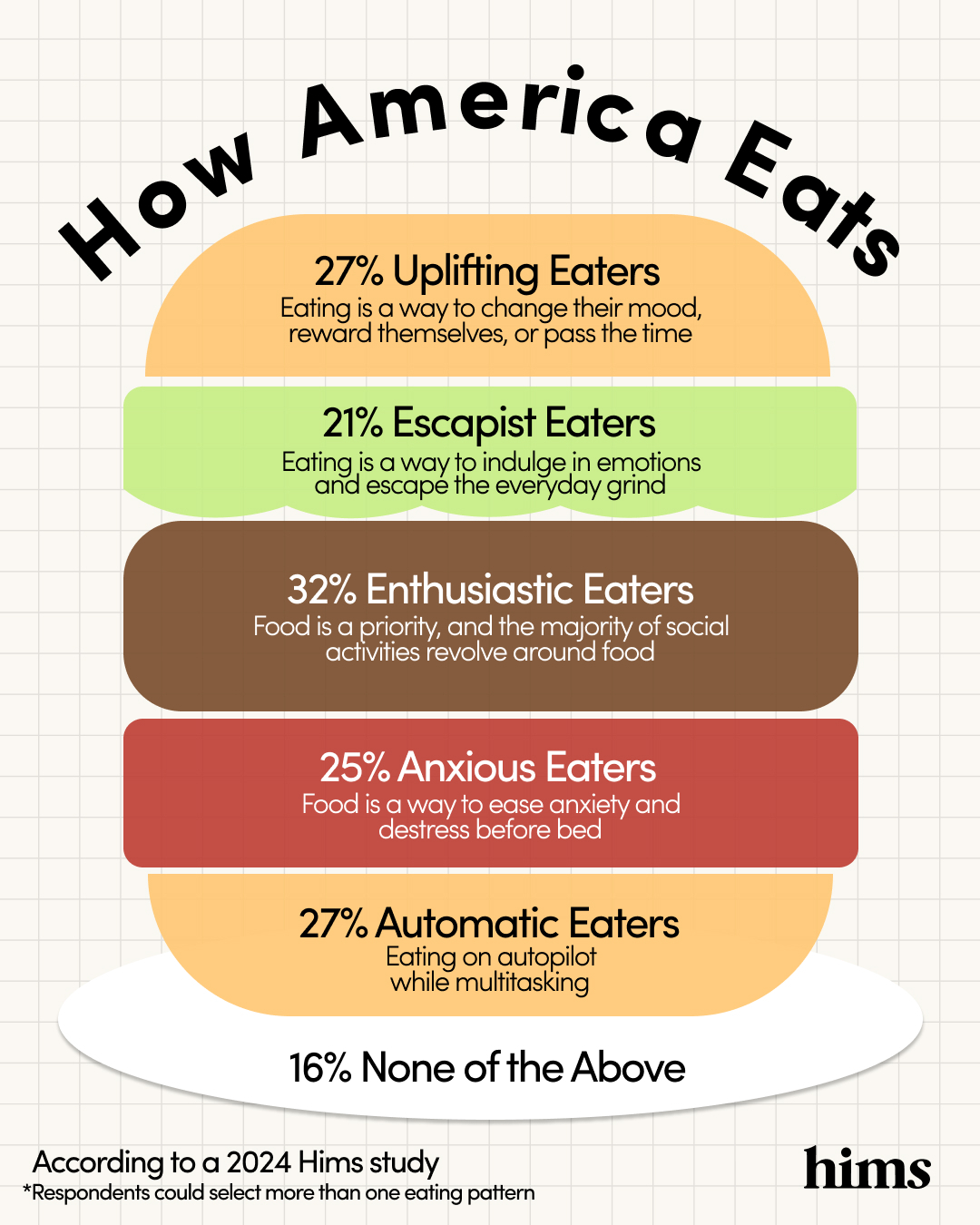Does where you live determine how you eat? New study uncovers America's emotional eating patterns

Marcus E Jones // Shutterstock
Does where you live determine how you eat? New study uncovers America’s emotional eating patterns
People walking down French Quarter where restaurants and bars are along Bourbon Street in New Orleans.
Where you live may influence your eating and health habits more than you think.
Do you savor every meal or squeeze in a sandwich during your commute? Are you more likely to indulge in comfort foods while watching your favorite show or try new foods dining out with friends? Personality plays a part, but a 2024 Hims study shows regionality may also play a significant role in eating behavior.
Hims compares America’s most anxious, automatic, enthusiastic, escapist, and uplifting foodie capitals.
What Are Eating Patterns?
There’s more to weight loss than just diet and exercise. While nutrition and movement play a large role, there’s also a behavioral component to holistic weight loss. A team of psychologists and weight loss experts at Hims have identified five eating patterns that typically describe people’s primary eating habits: anxious, automatic, enthusiastic, escapist, and uplifting.
- Anxious: I tend to eat when I’m stressed, anxious, or can’t sleep.
- Automatic: I tend to eat on autopilot, while multitasking.
- Enthusiastic: I make food a priority. The majority of my social activities revolve around eating.
- Escapist: I tend to be an emotional eater, and eat to escape or indulge in an emotion.
- Uplifting: I eat when I’m bored, to change my mood, or to reward myself.
How America Eats
Hims asked people which eating pattern best describes their primary eating habits (selecting all that apply) and looked at trends in major cities across the country to determine if where they live impacts their eating habits. 84% of Americans fit into one of five eating patterns. Here’s how the country stacks up.
- Enthusiastic eaters: 32%
- Automatic eaters: 27%
- Uplifting eaters: 27%
- Anxious eaters: 25%
- Escapist eaters: 21%
- None of the above: 16%
![]()

Hims
America’s Most Enthusiastic Eaters: New Orleans
Infographic showing Hims’ stats on how America eats.
The Big Easy is known for its world-renowned foodie culture. So it’s no wonder that New Orleans tops the list of America’s most Enthusiastic Eaters, with nearly half (45%) of New Orleanians reporting that the majority of their social activities revolve around food, compared to 32% of Americans overall.
So, what’s the recipe for their enthusiasm? First, they are quite a bit more social than the rest of America. 66% of residents of New Orleans describe themselves as “extroverted” as compared to just 31% of the nationally representative population. Prioritizing food in one’s social life is a key part of being an Enthusiastic Eater.
Second, they’re experimental. 60% of New Orleans residents identify as such compared to 39% of the U.S. population. Likely, they are open to—and enthusiastic about—trying new cuisine.
Lastly, they are more likely than almost any city in the country to self-identify as “multicultural.” Two-thirds (66%) say they cross multiple races, ethnicities, or cultures, as compared to 30% of Americans overall. The variety of cultures in their own backyard no doubt makes them enthusiastic to “culture sample” through food.
Percent who identify as Enthusiastic Eaters
- New Orleans, LA, 45%
- San Diego, CA, 44%
- New York, NY, 40%
- Austin, TX, 40%
- San Antonio, TX, 39%
- Las Vegas, NV, 39%
- Philadelphia, PA, 38%
- Nashville, TN, 38%
- Chicago, IL, 38%
- Los Angeles, CA, 37%
Nutrition Tips For Enthusiastic Eaters
- Practice mindfulness. When social activities revolve around food, opt for high-quality, nutritious options. Incorporate home-cooked meals into gatherings by hosting potlucks where everyone brings a healthy dish for a fun and nourishing experience.
- Balance food-centered events with physical activities. Consider getting outside for a stroll through Central Park, the French Quarter, or your city’s green space or cultural center before or after enjoying your favorite foods.
America’s Most Automatic Eaters: Atlanta
44% of Atlanta residents describe themselves as “Automatic Eaters” who multitask and tend to eat on autopilot. This compares to just 27% of the country who says they do the same.
Atlanta is also the top city to report that they are worried about their weight, with 33% of residents saying it tops their list of stressors vs. 25% of Americans overall.
Distracted or “mindless” eating can be a key contributor to consuming more calories than needed to nourish your body. When you eat on autopilot, it’s very easy to underestimate the volume of food you consume in a day.
Percent who identify as Automatic Eaters
- Atlanta, GA, 44%
- New York, NY, 38%
- Austin, TX, 36%
- Salt Lake City, UT, 35%
- St. Louis, MO, 34%
- Tampa, FL, 33%
- Orlando, FL, 33%
- Phoenix, AZ, 33%
- Chicago, IL, 33%
- Houston, TX, 32%
Nutrition Tips For Automatic Eaters
- Be intentional. Designate a specific area for meals that’s free from distractions. Creating a dedicated eating space encourages you to slow down and enjoy your food. Furthermore, choose specific times for meals where you focus solely on eating.
- Avoid distractions like screens or multitasking during these moments to cultivate mindfulness and enhance your eating experience.
- Meal prep. Plan and prepare your meals ahead of time so you have nutritions meals at the ready, reducing the temptation to eat automatically.
America’s Most Uplifting Eaters: San Antonio
San Antonio, Texas residents are one-third more likely than other top cities to say they are “Uplifting Eaters” using food to improve their mood when they’re feeling down (39% vs. 27%, respectively).
While eating to get out of a funk is common—as mentioned, 27% of Americans identify with this eating pattern most, making it the number two eating pattern after Enthusiastic Eaters—what Hims found in its research is that San Antonio needs some self-love.
San Antonio residents report feeling less emotionally stable than Americans overall (51% vs. 59%, respectively).
Percent who identify as Uplifting Eaters
- San Antonio, TX, 39%
- Sacramento, CA, 34%
- Salt Lake City, UT, 33%
- Houston, TX, 33%
- Atlanta, GA, 33%
- New Haven, CT, 32%
- Washington, DC, 32%
- Nashville, TN, 32%
- Baltimore, MD, 32%
- Greenville, SC, 32%
Nutrition Tips For Uplifting Eaters
- Try journaling. Keep a food journal that not only tracks what you eat, but also your mood during meals. Reflecting on how certain foods impact your emotions can help you make more mindful choices in the future. Other creative outlets are a good way to improve your mental state, as well.
- Use cooking as a way to uplift your mood by experimenting with new recipes or cuisines. Invite friends over for dinner and cook together, turning meal prep into a fun and engaging activity.
America’s Most Anxious Eaters: Salt Lake City
Statistically speaking, Salt Lake City residents are stressed out. 61% of Salt Lake City residents rate themselves as a 4 or 5 on being “stressed” as compared to just 37% of Americans overall.
They’re also the most likely in the country to say they turn to food when they’re stressed out, anxious, or can’t sleep: 38% identified as Anxious Eaters vs. 25% of total respondents.
Percent who identify as Anxious Eaters
- Salt Lake City, 38%
- Charlotte, NC, 37%
- St. Louis, MO, 35%
- San Antonio, TX, 34%
- Indianapolis, IN, 30%
- Washington, DC, 30%
- Greenville, SC, 29%
- Oklahoma City, OK, 29%
- Minneapolis, MN, 29%
- Tampa, FL, 28%
Nutrition Tips For Anxious Eaters
- Take a walk to destress and get your mind off food. Healthy coping mechanisms, like exercise, listening to music, playing with a pet, reading, playing sports, or calling a friend are all great ways to conquer stress and avoid self-soothing with food.
- Stock up on healthy snacks. Having healthy snacks on hand, especially when you’re feeling anxious, can help you make choices in the moment that you’ll feel good about later.
- Choose foods that may help with anxiety. Did you know that what you eat can impact your anxiety? Check out this list of the best foods for anxiety.
America’s Most Escapist Eaters: Minneapolis
Residents of Minnesota’s biggest metropolitan hub—Minneapolis-St. Paul—were the most likely to classify themselves as “Escapist Eaters” who use food to escape certain emotions (31% vs. 21% of respondents overall).
Minneapolis also ranked #1 in emotional stability, with 74% of Minneapolis and St. Paul residents saying they were highly emotionally stable (a 5 on a 5-point scale) or emotionally stable (a 4 on a 5-point scale) as compared to just 59% of Americans overall. And 78% report being “happy” vs. 66% of the rest of the country.
Percent who identify as Escapist Eaters
- Minneapolis-St. Paul, MN, 31%
- San Francisco, CA, 29%
- Chicago, IL, 29%
- Oklahoma City, OK, 29%
- Norfolk, VA, 27%
- Orlando, FL, 27%
- Dallas, TX, 27%
- Sacramento, CA, 26%
- Miami, FL, 26%
- Salt Lake City, UT, 26%
Nutrition Tips For Escapist Eaters
- Check in with yourself emotionally before indulging. Emotional awareness can be a key component of a healthier eating habit. Set reminders on your phone to pause and assess your feelings, helping you differentiate between emotional and physical hunger.
- Consider channeling your emotions into artistic activities such as painting, writing, or playing music instead of food. These activities can provide a therapeutic release for your feelings and reduce the urge to eat for purely emotional reasons.
Data & Methodology
This study is based on a 5,504-person online survey, which included 5,000 18-to-65-year-old respondents in the top 50 metropolitan areas (100 respondents per city) and a nationally representative sample of 504 18-to-65-year-old respondents to contextualize results. The study was fielded in May 2024.
Hims asked respondents, “Which of the following best describe your primary eating habits?” and asked them to select all that apply. Findings were analyzed by more than 100 demographic and psychographic cuts, including city, region, gender (when Hims refers to “women” and “men,” this includes all people who self-identify as such), age, race and ethnicity, relationship status, parenting status, sexual orientation (heterosexual, bisexual, gay, lesbian, pansexual, asexual, queer, etc.), and political affiliation, among other areas of interest.
All data in this study are from this source, unless otherwise noted. Independent research firm, Culture Co-op, conducted and analyzed research and findings. Get the data.
This story was produced by Hims and reviewed and distributed by Stacker Media.